Question and Answer – July 2008
First, an apology. I broke my right index finger stumbling on a broken chunk of sidewalk just outside Fair Park in Dallas last Sunday evening. I was carrying my 2-year-old granddaughter, and both of us fell into Parry Avenue. Lauren is tough, and thank God she’s OK. My hands and knee are a bit worse for the trip down. Questions will have minimal editing, and answers will be shorter than usual this month. I have answered only those questions with digital photos. If you don’t have photos, please feel free to call either of my weekend radio programs with your question. Click here for the phone numbers.
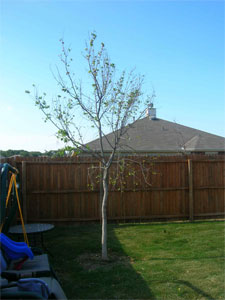
Question: We have a maple tree that was planted in February 2007 when we purchased our new home. We have a mixture of red and gray clay soil (mostly red). The tree did beautifully through Spring ’07, Fall ’07 and Winter ’07. We continued to water the tree on a regular basis throughout the winter. The tree began to leaf out in late February and appeared to be doing fine until about a month ago. It started to drop its leaves from the bottom branches, and the leaf loss has continued up the tree over the past month. We’ve also noticed fly-looking insects constantly flitting around the branches. I’ve attached a picture of the insect and the tree itself. Can the tree be saved? R.C., Corinth
Answer: My best guess would be that you need to look for a new tree, maybe an oak, cedar elm or Chinese pistachio. The insect in your unused photo is not the cause of your tree’s problems, but it does appear that borers could be. It’s doubtful this tree can be saved.
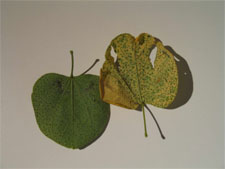
Question: We planted our redbud tree 3 years ago. Last year the leaves suddenly developed these tiny brown spots on the underside that then bled through to the topside. The leaves then turn yellow and drop off the tree. The entire process occurs within just a few days. We thought it was a fungus and have treated it regularly with fungicide. The leaves came back healthy this year, then suddenly we noticed the brown spots have returned and the leaves are yellowing and falling off again. Any idea what else we might be dealing with? R., no city given.
Answer: Your diagnosis was correct. This is a fairly common fungal leaf spot for redbuds. You should probably begin your fungicide treatments earlier next year, before the problem breaks out. By the time the leaves are this spotted, they’re going to go ahead and drop. Hopefully the tree will still have some inherent vigor left after this season.
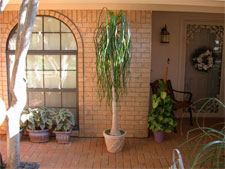
Question: I have had this pony tail for at least 31 years! During the winter months it is placed in our south-facing garage with fluorescent lighting. It is over 6 feet tall and it’s getting hard to find the right placement for it in our yard, and also it’s difficult to move it around to get it in a protected area when hail, high wind, etc. are in the forecast. A local nursery has one with a slightly smaller base size. Its top had been cut off and it now has three “shoots” growing right below the cut line. I would like to do this to mine. Is there anything special I need to do to guarantee success in cutting the top off and having a good outcome a few years from now? Also, when would be the best time to do this? C.J., Fort Worth.
Answer: I have walked the path before you. I have a 32-year family-member pony tail, and I’ve had to do the very same thing. Spring would be the ideal time, since it would give the plant all season to regrow. However, you could still do it now if you hurry. Make the cut where you want the shoots to be. They will sprout out only slightly below your cut. It will probably look good within months, not years.
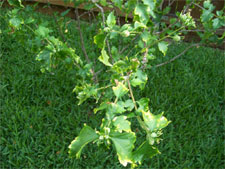
Question: Please, can you tell me what is the matter with my rose of Sharon? They were growing well and blooming each summer, but this spring their leaves look like they are dying. E.J., no city given.
Answer: Thanks for wording your question that way. No, I can’t tell you for sure. Cotton root rot is the plant’s most common problem (alkaline-soil areas only), but that’s not the problem here. This really appears to be nutritional. Either the plant needs a good, balanced fertilizer, or it could be because of injury to the roots or trunk that could be causing the shortage of nutrients moving up to the leaves. Sorry not to be of more help.
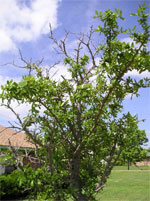
Question: Attached are photos of my live oak. It is about 10 years old. It has never really looked great, but the last few years it has begun to look bad! From some reading I have done, I wonder if it was planted too deep. Is there any hope, or should we just take it out and start over? If so, should we wait until February to replant? M., Rockwall.
Answer: This tree definitely is not doing well. Planting it lower than it was growing originally would definitely cause this, but so could trunk damage. It’s time for a new tree. Fall is the very best time to plant it.
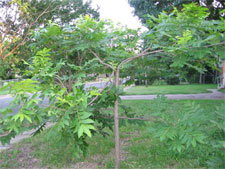
Question: I have a young pecan tree in my yard that is about 8 feet tall and has been developing nicely the last few years. After a recent storm with heavy winds I found that one of the larger top branches had broken. It’s split and kind of hanging. At first I thought to pull it all the way off. But the tree has huge sentimental value to me and it’s such a big branch and so leafy, I couldn’t bring myself to do it. Can the branch be saved by some kind of repair? Or would it be better to take it off and let the tree heal? Now I find new growth on the branch so I’m really confused. S.F., Dallas.
Answer: You need to trim it off flush. (Do not pull it!) You probably should do some additional trimming of the remaining branches to force them to produce new shoots closer to the trunk. Without that significant reshaping, the tree will probably never develop a good form. Prune the broken branch now, but save the reshaping for winter.
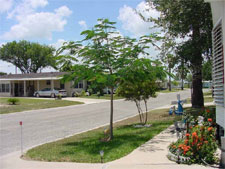
Question: I saved some royal poinciana seeds and planted them. I got a tree started. It is very well branched out now, but I have no blooms. I see many other such trees in our area that are just blooming their hearts out! Why would my tree not be blooming? Am I perhaps watering it too much? P.H., no city given.
Answer: Your plant appears to be young and extremely vegetative. It takes shrubs, and especially trees, a few years to become mature enough to bloom well. Don’t worry about the watering, but avoid high-nitrogen fertilizers the rest of this year.
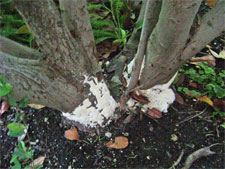
Question: I can’t figure out what this white stuff is around the bottom of my redtip photinia trunk. If you can tell what it is from the picture, what can I do about it? M.H., no city given.
Answer: I’m going to assume your plant is doing well otherwise since you said nothing to the contrary. This is a saprophytic fungus that is living off dead organic matter. It will probably go away as hot, dry weather settles in. Dusting sulfur would stop it if you’re concerned. Be sure there is no decay beneath the bark.
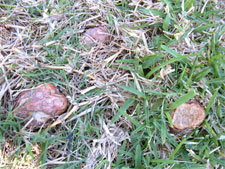
Question: I’m sending several pictures of the knees under our bald cypress tree. I wasn’t told this tree would do this eventually, so we were puzzled and surprised to see the knees start coming up out of the ground directly below the tree. Can you help us with what to do with them? We end up tripping over them. Is there a solution to this problem, or do we plant groundcover under the tree and add brick or metal edging around them? The tree is about 7 years old and is a pretty tree. No initials given, Azle.
Answer: Not all bald cypresses produce knees, but many will. The best way of dealing with them is to remove them with a sharp, long-handled axe. Be careful as you cut and remove them one knee at a time. Do not put edging in place. The knees will merely push it up and out of the soil. If you plant a groundcover, the knees will eventually grow taller than it is. Great trees, but with a couple of major issues. Knees are one. Iron deficiency is another in alkaline soils. Bagworms are a third.
